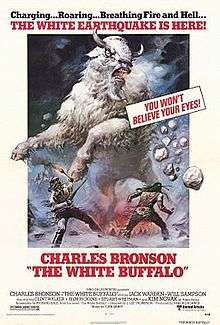The White Buffalo
| The White Buffalo | |
|---|---|
 White Buffalo theatrical poster. | |
| Directed by | J. Lee Thompson |
| Produced by | Dino De Laurentiis |
| Written by | Richard Sale |
| Based on | novel by Richard Sale |
| Starring |
Charles Bronson Jack Warden Will Sampson Kim Novak |
| Music by | John Barry |
| Cinematography | Paul Lohmann |
| Edited by | Michael F. Anderson |
| Distributed by |
United Artists Village Roadshow Pictures (Australia) |
Release date |
|
Running time | 97 min. |
| Country | United States |
| Language | English |
| Budget | $6 million[1] |
The White Buffalo is a 1977 western film starring Charles Bronson, Kim Novak, Jack Warden, Slim Pickens, and Will Sampson.[2] The film is directed by J. Lee Thompson, who frequently teamed with Bronson. It was also the final film Bronson made for United Artists.
The movie marks the second collaboration between Bronson and director J. Lee Thompson (following 1976's St. Ives).
Plot
Wild Bill Hickok is haunted by his dreams of a giant white buffalo. So much that he travels the West to find the beast. Along the way, Hickok meets Crazy Horse, who is also searching the plains for the giant white buffalo, who has killed Crazy Horse's daughter. Hickok and Crazy Horse team up to kill the elusive buffalo.
Main cast
- Charles Bronson ... Wild Bill Hickok
- Will Sampson ... Crazy Horse
- Jack Warden ... Charlie Zane
- Slim Pickens ... Abel Pickney
- Kim Novak ... Poker Jenny Schermerhorn
- Clint Walker ... Whistling Jack Kileen
- Stuart Whitman ... Winifred Coxy
- John Carradine ... Amos Briggs
- Ron Thompson ... Frozen Dog Pimp
Production
The film was based on a novel by Richard Sale, published in 1975. Reviewing the novel, Larry McMurtry said Sale "chose a topic with great possibilities, turned it into a sharpened stake and proceeded to impale himself on it."[3]
Film rights were bought by Dino De Laurentiis who signed Sale to adapt the novel. Sale said De Laurentiis was, along with Daryl Zanuck, one of the finest producers he ever worked with.[4]
Bronson signed to make the film in July 1975.[5]
"It's a Moby Dick of the west,"said director J. Lee Thompson. "It's a film we hope will work on many levels. On the first it is a wonderful, sensitive story between Wild Bill Hickok and the great Indian chief Crazy Horse. On the second it talks of a man having to find himself, seek his destiny, rid himself of fears and become more human."[1]
Much of the film was shot on a sound-stage in Los Angeles with location shots in Colorado and New Mexico. For the buffalo scenes, producer Laurentiis hired Carlo Rambaldi to design an animatronic full-size bison that would slide around on tracks. This was based on his larger-scale work on their previous collaboration King Kong (1976).[6]
Actors Ed Lauter and David Roya were similarly involved in King Kong, along with composer John Barry.
Additional notes
In the film, Wild Bill Hickok often wears dark glasses. There is a factual basis to this characterization. In 1876, Hickok was diagnosed by a doctor in Kansas City, Missouri, with glaucoma and "ophthalmia." Actually, he was probably afflicted with trachoma, a common vision disorder of the time.
The movie screened on TV under the title Hunt to Kill.[7]
References
- 1 2 An Intrepid Gunfighter Meets Fear Gallo, William. Los Angeles Times25 July 1976: c1.
- ↑ "The White Buffalo". The New York Times.
- ↑ Two Not Quite Historic Books: Book World NIGHT OF THE SILENT DRUMS. THE WHITE BUFFALO. By John L. Anderson (Seribner's. 406 PP. $9.95) By Richard Sale (Simon & Schuster. 253 pp. $7.95) Reviewed by Larry McMurtry The Washington Post 22 Sep 1975: B5.
- ↑ Looking Up to De Laurentiis Sale, Richard. Los Angeles Times 12 Dec 1976: t2.
- ↑ A Tribute to a Good Shepherd Murphy, Mary. Los Angeles Times 15 Nov 1975: a8.
- ↑ 'Mad as Hell' in Beverly Hills Lee, Grant. Los Angeles Times 17 Nov 1976: f17.
- ↑ HE REJECTS PEEPING-TOM COMEDIES Ryan, Desmond. Philadelphia Inquirer14 Aug 1983: H.4.
External links